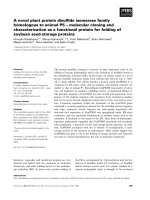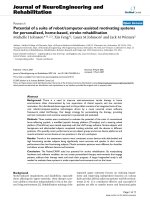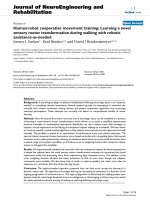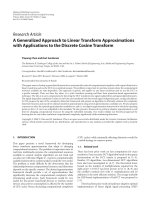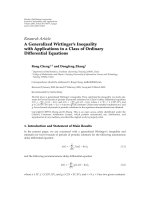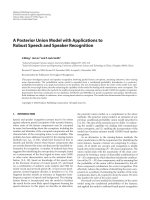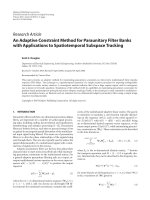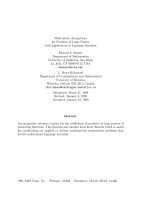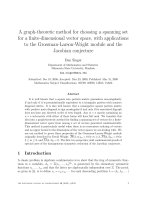A novel meshfree smoothed least squares(SLS) method with applications to dielectrophoresis simulations
Bạn đang xem bản rút gọn của tài liệu. Xem và tải ngay bản đầy đủ của tài liệu tại đây (3.18 MB, 235 trang )
Acknowledgements
i
Acknowledgements
I would like to express my deepest gratitude and sincerest appreciation to my
supervisor, Professor Liu Gui-Rong, for his invaluable guidance, dedicated support
and continuous encouragement throughout my four years Ph.D. study. His passion
and enthusiasm in research has inspired me enormously and will continue to influence
me for a life time. I would also like to extend my gratitude to my co-supervisor,
Assistant Professor Li Hua for his great help and valuable guidance in my research
work.
Many thanks are conveyed to my fellow colleagues and friends in Center for
ACES, Dr. Gu Yuan Tong, Dr. Dai Keyang, Dr. Zhang Guiyong, Dr. Zhao Xin, Dr.
Deng Bin, Mr. Li Zirui, Mr Bernard Kee Buck Tong, Mr. Zhang Jian, Mr. Khin Zaw, Ms.
Chen Yuan, Mr. Trung, and Mr. George Xu. I would like to thank them all for their
helpful discussions, constructive suggestions, as well as their inspirations and
encouragement throughout the course of my Ph.D study. I sincerely appreciate their
friendship and support.
I am grateful to every one of my family members, my parents, my younger sister
and younger brother, for their continuous support and encouragement which made my
Ph.D years meaningful and happy. Last but not least, I must thank the National
University of Singapore for granting me research scholarship. Many thanks are due to
Mechanical department and Center for ACES for their material support to every aspect
of this work.
Table of Content
i
Table of contents
Acknowledgements i
Table of contents i
Summary vi
Nomenclature ix
List of Figures xi
List of Tables xviii
Chapter 1 Introduction 1
1.1 Background 1
1.1.1 Meshfree methods 1
1.1.2 Classification of meshfree method 6
1.1.3 Dielectrophoresis background 8
1.2 Literature review 10
1.2.1 A review of meshfree methods 10
1.2.1.1 SPH and RKPM method 10
1.2.1.2 The EFG method 11
1.2.1.3 The MLPG method 12
1.2.1.4 Point interplolation method (PIM) 12
1.2.2 Studies of dielectrophoresis 13
1.3 A review of meshfree shape functions 17
1.3.1 Moving least-squares (MLS) approximation 18
1.3.1.1 Formulation procedure of MLS 18
1.3.1.2 Weight functions 22
Table of Content
ii
1.3.1.3 Properties of MLS shape functions 24
1.3.2 Polynomial point interpolation method (Polynomial PIM) 25
1.3.2.1 Formulation procedure of Polynomial PIM 25
1.3.2.2 Properties of polynomial PIM Shape Functions 28
1.3.2.3 Techniques for overcoming singularity in moment matrix 31
1.3.3 Radial point interpolation method (RPIM) 33
1.3.3.1 Formulation procedure of RPIM 33
1.3.3.2 Property of RPIM shape function 36
1.3.3.3 Implementation Issues 38
1.4 Objectives of the thesis 39
1.5 Organization of the thesis 41
Chapter 2 Development of a novel meshfree smoothed
least-squares (SLS) method 45
2.1 Introduction 45
2.2 Meshfree smoothed least-squares (SLS) formulation 47
2.2.1 General least-squares formulations 48
2.2.2 Gradient smoothing 50
2.3 Numerical Examples 52
2.3.1 One-dimensional problems 52
2.3.1.1 Convection-diffusion problem 52
2.3.1.2 Pure convection problem 54
2.3.2 Two-dimensional problems 56
2.4 Remarks 61
Chapter 3 Validation of the developed meshfree smoothed
least-squares (SLS) method for linear elasticity 72
3.1 Introduction 72
Table of Content
iii
3.2 The SLS formulation for linear elasticity problem 73
3.3 Elasticity problems 77
3.3.1 2-D Standard patch test 77
3.3.2 Cantilever beam subjected to a parabolic shear traction at the end 78
3.3.3 An infinite plate subjected to uniaxial traction along horizontal direction
…………………………………………………………………… 80
3.4 Remarks 82
Chapter 4 Validation of the developed meshfree smoothed
least-squares (SLS) method for steady incompressible flow 92
4.1 Introduction 92
4.2 The Navier-Stokes equations in the velocity-pressure-vorticity formulation
…………………………………………………………………………… 94
4.3 The SLS formulation for Navier-Stokes equations 97
4.4 Steady incompressible flow problems 99
4.4.1 A model problem for Stokes equations 99
4.4.2 Driven cavity flow problem for Stokes equations 101
4.4.3 Driven cavity flow problem for Navier -Stokes equations 102
4.4.4 Backward-facing step flow problem 103
4.5 Remarks 103
Chapter 5 Application of the meshfree smoothed least-squares
(SLS) method for dielectrophoresis 117
5.1 Introduction 117
5.2 Dielectrophoresis theory 118
5.3 Meshfree smoothed least-squares formulation for dielectrophoresis 119
5.4 Dielectrophoresis simulation 122
Table of Content
iv
5.5 Remarks 126
Chapter 6 Simulation of an extruded quadrupolar
dielectrophoretic trap 133
6.1 Introduction 133
6.2 Radial point collocation method (RPCM) 134
6.3 Meshless finite difference method 138
6.4 Simulation of extruded quadruple trap 143
6.4.1 Governing equations and boundary conditions 143
6.4.2 Determination of dielectrophoretic forces 145
6.4.3 Determination of hydrodynamic forces 146
6.4.4 Determination of the total resultant force 147
6.4.5 Validation with experimental results 147
6.4.5.1 Comparison between RPCM and MFD 148
6.4.5.2 Comparison between numerical prediction and experimental results
……………………………………………………………………148
6.4.6 Results and discussion 150
6.4.6.1 Results for resultant force field 150
6.4.6.2 Variation of holding characteristic with trap geometry 152
6.4.6.3 Variation of holding characteristic with particle radius 154
6.4.6.4 Variation of holding characteristic with Clausius-Mossotti factor 155
6.5 Remarks 155
Chapter 7 Simulation of an interdigitated dielectrophoretic array
166
7.1 Introduction 166
7.2 Additional dielectrophoresis theories 167
7.3 Linearly conforming point interpolation method (LC-PIM) 169
Table of Content
v
7.3.1 Node selection 169
7.3.2 Gradient smoothing 171
7.3.3 Variational form 173
7.4 Results and discussion 175
7.4.1 Simulation of the DEP array 176
7.4.1.1 Linear potential change in the gap 177
7.4.1.2 Exact boundary condition in the gap 178
7.4.2 Simulation of the traveling wave DEP array 179
7.4.2.1 Study of the traveling wave DEP array 179
7.4.3 Simulation results using RPIM shape function 180
7.5 Remarks 182
Chapter 8 Conclusion and future work 201
8.1 Conclusion remarks 201
8.2 Recommendations for future research 205
References 207
Publications arising from thesis 216
Summary
vi
Summary
Mesh-based numerical methods, such as finite element method (FEM), and finite
difference method (FDM), have been the primary numerical techniques in engineering
computations. Due to mesh related problems of these methods, a new group of
numerical techniques called meshfree methods have been proposed and developed in
recent years. Many different methods and techniques have been developed for
applications in different engineering fields. It has been a standard practice to employ
different numerical schemes for different types of differential equations in engineering
problems.
This thesis focuses on the development and application of a unified meshfree
method applicable for all types of differential equations that govern practical
engineering problems. The objectives of the present study are two-fold: One is to
develop new meshfree method with a unified formulation so that it can be potentially
applied to all engineering problems; the other is to apply the developed and existing
meshfree methods to simulations of dielectrophoresis (DEP) based devices, which have
attracted great attention in recent Micro-Electro-Mechanical Systems (MEMS)
researches.
The first contribution of this thesis is development of the meshfree smoothed
least-squares (SLS) method based on first-order least-squares formulation. The
meshfree SLS method uses a unified formulation for all types of partial differential
equations: elliptic, parabolic, hyperbolic or mixed. As long as the equations are well
Summary
vii
posed and have a unique solution, the SLS method can always produce a good
approximate solution. The properties of the SLS method have been studied in details.
The SLS method is found particularly effective for solving non-self-adjoint system
such as the convection dominated problem, which is difficult to solve by conventional
Galerkin methods. The SLS method always leads to symmetric positive-definite
matrices which can be efficiently solved by iterative methods. Using the SLS method,
no special treatments, such as upwinding, artificial dissipation, staggered grid or
non-equal-order elements, operator-preconditioning, etc are needed.
In the second part, the SLS method is devoted to numerical analysis of various
engineering problems, including linear elastic problems, incompressible steady flow
problem, and dielectrophoresis problem, etc. It is found that the SLS method achieves
better accuracy and convergence rate, comparing with other methods based on Galerkin
formulation. The SLS method is based on first-order least-squares method, so that the
primary variables and the derivatives can be solved simultaneously and with the same
order of accuracy. This unique feature is of very importance for many practical
problems where it is essential to obtain accurate solutions in the derivatives, such as
strain and stress in elasticity problems, flux in fluid problems.
The last part of the thesis deals with simulations of DEP based systems using
meshfree techniques. A strong-form meshfree method termed radial point collocation
method (RPCM) is used to simulate the extruded quadrupolar DEP trap. Compared to
weak-form methods, strong-form methods are easy to implement and have lower
computational cost. The model developed is able to approximate the strength of the
trap, and it can also be used for design optimization purpose. The model is validated
Summary
viii
with good accuracy by comparing with experimental data. Another meshfree
technique, linear conforming point interpolation method (LC-PIM) is used for
simulation of the dielectrophoretic array as well as the traveling wave
dielectrophoretic array. LC-PIM has been found to be very effective to capture the
high gradient feature of the electric field, and can produce accurate results for
derivatives of the shape functions, which are important for computing the DEP forces
in DEP related simulations. The results have been compared with the analytical
solution obtained using Fourier series analysis, good accuracy has been demonstrated.
Nomenclature
ix
Nomenclature
a
Coefficient vector
A
Linear differential operator
B
Boundary algebraic operator
c
d
Characteristic length (average nodal spacing)
E Young’s modulus
m
ε
Permittivity of medium
p
ε
Permittivity of particle
CM
f
Clausius-Mossotti (CM) factor
f
Force vector
K
Stiffness matrix
(), ()LB
Differential operator
2
()ΩL
Hilbert space
n
Vector of unit outward normal
n Number of supporting nodes
N(x)
Vector of shape functions
()
px
Polynomial basis function
m
P
Polynomial moment matrix
q Shape parameter of MQ radial basis function
r Distance
w
r
Size of weight function domain
R
Residual function
()
R x
Radial basis function
Q
R
Moment matrix of radial basis function
Nomenclature
x
Re
Reynolds number
T Delaunay cell
t
Specified traction vector
U
Displacement vector
s
U
Displacement vector of local support domain
u
Specified displacement vector
u
Field function
h
u
Approximation of field function u
v
Trial function
0
V
Voltage
w
)
Weight function or smoothing function
[]
T
x
yz=x
Cartesian coordinate
c
α
Parameter of MQ radial basis function
Γ
Boundary of problem domain
u
Γ
Dirichlet boundary
t
Γ
Neumann boundary
δ
Kronecker delta
m
σ
Conductivity of medium
p
σ
Conductivity of particle
Ω
Problem domain
List of Figures
xi
List of Figures
Figure 1.1 Pascal triangle of monomials for two dimensional spaces. 44
Figure 2.1.Illustration of background triangular cells and formation of nodal
representative domain 65
Figure 2.2 Results of u for convection-diffusion problem with different Pelect
numbers using SLS meshfree method. A total of 21 regularly
distributed nodes are used 65
Figure 2.3 Results of
dxdu /
for convection-diffusion problem with different
Pelect numbers using SLS meshfree method. A total of 21 regularly
distributed nodes are used 66
Figure 2.4 Results of
u
for convection-diffusion problem with Pelect =0.25 66
Figure 2.5 Results of
u
for convection-diffusion problem with Pelect =1.25 67
Figure 2.6. Comparing solutions of pure convective problem with
ε
=0.05 for
difference numerical methods 67
Figure 2.7. Comparing solutions of pure convective problem with
ε
=0.05 for
difference numerical methods 68
Figure 2.8 Convergence of primary variables for Laplace example 1 68
Figure 2.9 Convergence of dual variables for Laplace example 1 69
Figure 2.10 Irregular nodal distribution in Laplace example 2 70
Figure 2.11 Convergence of primary variables for Laplace example 2 70
Figure 2.12 Convergence of dual variables for Laplace example 2 71
Figure 3.1 (a) Patch a with 16 irregular distributed nodes and (b) Patch b with 25
irregularly distributed nodes (c) Patch c with 36 irregularly
distributed nodes 84
Figure 3.2 A two-dimensional cantilever solid subjected to a parabolic traction on
the right edge 84
List of Figures
xii
Figure 3.3 Boundary conditions for cantilever beam problem 85
Figure 3.4 Deflection distribution along the neutral line. 85
Figure 3.5 Shear stress distribution along the line 2/Lx
=
. 86
Figure 3.6 Relative errors in displacement norm for beam problem 86
Figure 3.7 Relative errors in energy norm for beam problem 87
Figure 3.8 Infinite two-dimensional solid with a circular hole subjected to a
tensile force and its quarter model 87
Figure 3.9. Boundary conditions for Infinite plate with a circular hole problem 88
Figure 3.10 Distribution of
x
U along the bottom edge for infinite plate with a
circular hole problem 88
Figure 3.11 Distribution of
y
U
along the left edge for infinite plate with a
circular hole problem 89
Figure 3.12 Stress distribution along the left edge for infinite plate with a circular
hole problem 89
Figure 3.13 Relative errors in displacement norm for plate with a circular hole
problem 90
Figure 3.14 Relative errors in energy norm for plate with a circular hole problem
90
Figure 3.15 Change of relative errors in energy norm with Poisson ratio for plate
with a circular hole problem 91
Figure 4.1. Boundary conditions for Stokes model problem 105
Figure 4.2. Node distributions for Stokes model problem 106
Figure 4.3. Computed convergence rate for Stokes model problem. (a) 2nd-order
polynomial basis with boundary condition 1 from Figure 4.1 (b)
2nd-order polynomial basis with boundary condition 2 from Figure
4.1 (c) 2nd-order polynomial basis with boundary condition 3 from
Figure 4.1 107
List of Figures
xiii
Figure 4.4. The boundary conditions for driven cavity flow 108
Figure 4.5.Computed results for lid-driven cavity flow problem. (a) Pressure. (b)
Vorticity (c) Streamline. (d) velocity. 108
Figure 4.6.Node distribution for driven cavity flow problem 109
Figure 4.7. Computed results for lid-driven cavity flow problem at Re = 1000.
(a) Pressure. (b) Vorticity (c) Streamline. (d) velocity 109
Figure 4.8. Computed results for lid-driven cavity flow problem at Re = 5000.
(a) Pressure. (b) Vorticity (c) Streamline. (d) velocity 110
Figure 4.9 (a)Comparison of v-velocity along horizontal line through geometric
center; (b) (a)Comparison of u-velocity along vertical line through
geometric center; 111
Figure 4.10.Boundary conditions for backward facing step flow problem 112
Figure 4.11. Computed results for backward facing step flow problem at Re =200
113
Figure 4.12. Computed results for backward facing step flow problem at Re =400
114
Figure 4.13. Computed results for backward facing step flow problem at Re =600
115
Figure 4.14. Reattachement length versus Reynolds number for backward-facing
flow. 116
Figure 5.1. Ilustration of dielectrophoresis in a point-plane electrode system. If
particle is more polarizable than surrounding medium, it moves
towards highest electric field region due to positive dielectrophoresis;
If particle is less polarizable than surrounding medium, it is repelled
from highest electric field region due to negative dielectrophoresis.
127
Figure 5.2. A typical interdigitated electrode array 127
Figure 5.3 Schematic of the boundary condition on the bottom 128
Figure 5.4 Boundary condition of one unit cell. 128
List of Figures
xiv
Figure 5.5.Contour plot of electric potential in one unit cell 129
Figure 5.6. Contour plot of electric field in one unit cell 129
Figure 5.7. Computed solution for distribution of
,
'
D
EP x
F
130
Figure 5.8. Computed solution for distribution of
,
'
D
EP y
F
130
Figure 5.9. Computed solution for distribution of '
D
EP
F 131
Figure 5.10 Computed solution for distribution of
,
D
EP y
F
131
Figure 5.11 Computed solution on middle vertical line x’=1 132
Figure 6.1 A problem governed by PDEs in domain
Ω
. 158
Figure 6.2 (a) Extruded quadrupolar DEP trap (Voldman, website); (b)
Simulation domain for the simplified 2-D model (in
m
μ
) 159
Figure 6.3 llustration of boundary conditions 159
Figure 6.4 Comparison of electric potential between RPCM and LSFD on line y
=-30 160
Figure 6.5 Comparison of convergence between RPCM and LSFD. 160
Figure 6.6 Non-dimensional Electric potential field obtained using RPCM. 161
Figure 6.7 Numerical and experimental results comparison for 13.2 m
μ
diameter
beads. 161
Figure 6.8 Numerical and experimental results comparison for 10 m
μ
diameter
beads 162
Figure 6.9 Determination of release flow velocity 162
Figure 6.10 Variation of release flow velocity with voltage. 163
Figure 6.11 Effect of trap length on strength of the trap 163
List of Figures
xv
Figure 6.12 Effect of entrance posts separation on strength of the trap 164
Figure 6.13 Effect of exit posts separation on strength of the trap. 164
Figure 6.14 Change of CM factor with frequency in different fluid 165
Figure 7.1 Illustration of background cells of triangles and the selection of
supporting nodes 183
Figure 7.2 Illustration of background triangular cells and formation of nodal
representative domain 183
Figure 7.3 Interdigitated electrode array used for dielectrophoretic separation and
traveling wave dielectrophoresis 184
Figure 7.4 . Boundary conditions of a unit cell in dielectrophoresis array 184
Figure 7.5 Solution of the problem near the electrode. (a) The electric potential
'
φ
(b) The magnitude of electric field |'|
R
φ
∇ (c) The magnitude of
vector
2
|'|
R
φ
∇∇
(d) The direction of vector
2
|'|
R
φ
∇∇
186
Figure 7.6 Comparison of numerical and analytical solution on middle vertical
line x’=1 (a) comparison of electric field magnitude
||
R
φ
∇ (b)
comparison of magnitude of vector
2
||
R
φ
∇∇
. 187
Figure 7.7 Comparison of numerical and analytical solution on horizontal line
y’=0.1 (a) comparison of electric field magnitude
||
R
φ
∇
(b)
comparison of magnitude of vector
2
||
R
φ
∇∇
188
Figure 7.8 Comparing magnitude of
2
||
R
φ
∇∇
189
Figure 7.9 Boundary conditions for a unit cell of traveling wave array 189
Figure 7.10 Solution of electric potential for traveling wave array. (a) Real part
of potential phasor
R
'
φ
(b) Imaginary part of potential phasor
I
'
φ
190
List of Figures
xvi
Figure 7.11 Solution of the cDEP force component. (a)Magnitude of the vector
)|''||''(|'
22
IR
φφ
∇+∇∇
(b) Direction of the vector
)|''||''(|'
22
IR
φφ
∇+∇∇
191
Figure 7.12 Solution of the twDEP force component. (a)Magnitude of the vector
)''''('
IR
φ
φ
×∇∇×∇
(b) Direction of the vector
)''''('
IR
φ
φ
×∇∇
×
∇
192
Figure 7.13 Solution of the problem near the electrode (RPIM shape function is
used). (a) The electric potential '
φ
(b) The magnitude of electric
field
||
R
φ
∇
′
(c) The magnitude of vector
2
||
R
φ
∇
′
∇
′
(d) The
direction of vector
2
||
R
φ
∇
′
∇
′
194
Figure 7.14 Comparison of numerical and analytical solution on middle vertical
line x’=1(RPIM shape function is used) (a) comparison of electric
field magnitude
||
R
φ
∇
(b) comparison of magnitude of vector
2
||
R
φ
∇∇ 195
Figure 7.15 Comparison of numerical and analytical solution on horizontal line
y’=0.1(RPIM shape function is used) (a) comparison of electric
field magnitude
||
R
φ
∇
(b) comparison of magnitude of vector
2
||
R
φ
∇∇ 196
Figure 7.16 Comparing magnitude of
2
||
R
φ
∇∇ (RPIM shape function is used)
197
Figure 7.17 Solution of electric potential for traveling wave array. (RPIM shape
function is used) (a) Real part of potential phasor
R
'
φ
(b) Imaginary
part of potential phasor
I
'
φ
198
Figure 7.18. Solution of the cDEP force component. (RPIM shape function is
used) (a)Magnitude of the vector )|''||''(|'
22
IR
φφ
∇+∇∇ (b)
List of Figures
xvii
Direction of the vector )|''||''(|'
22
IR
φφ
∇+∇∇ 199
Figure 7.19. Solution of the cDEP force component. (RPIM shape function is
used) (a)Magnitude of the vector ' ( ' ' ' ' )
RI
φ
φ
∇
×∇ ×∇ (b)
Direction of the vector ' ( ' ' ' ' )
RI
φ
φ
∇
×∇ ×∇ 200
List of Tables
xviii
List of Tables
Table 1.1 Typical conventional form of radial basis functions. 44
Table 3.1. Error norm of SLS method for linear patch test. 83
Table 6.1 Schematic of geometrical parameters (R =10μ
m
is used as reference
parameter). 157
Table 6.2 Influence of particle radius on the release velocity 157
Chapter 1 Introduction
1
Chapter 1
Introduction
1.1 Background
1.1.1 Meshfree methods
In order to analyze an engineering system, a mathematical model is first developed
with some possible simplifications and assumptions to describe the physical
phenomenon of the system. These mathematical models are usually expressed in form
of governing equations with proper boundary conditions (BCs) and/or initial conditions
(ICs). The governing equations are generally differential equations, which are usually
difficult to solve analytically. With rapid development of computer technology, various
numerical techniques have been developed and applied to solve numerous complex
practical problems in engineering and applied science. The most popular numerical
methods include the finite difference method (FDM), the finite volume method (FVM),
the finite element method (FEM) and boundary element method (BEM), etc. In
particular, the FEM has become one of the major numerical solution techniques, and
widely used in engineering fields including solid mechanics, fluid flow, heat transfer,
electric fields, etc, due to its versatility for complex geometry and flexibility for various
Chapter 1 Introduction
2
linear and non-linear problems.
The FEM does not operate on the differential equations directly, instead, the
governing differential equations, whether being ordinary differential equations (ODEs)
or partial differential equations (PDEs), are transformed into equivalent variational
forms by means of certain principles, such as variational method, minimum potential
energy principle or principle of virtual work. The solution appears in an integral of a
quality over the problem domain. The integral of a function over a domain can be
divided into the sum of integrals over a collection of subdomains called finite element.
These elements are connected together by a topological map termed as mesh. As long
as the mesh is fine enough or the elements are sufficiently small, polynomial functions
can approximately represent the local behavior of the solution. One of the advantages
of the FEM is that it is essentially independent of geometry, and many domains of
complex shapes can be handled by the FEM with ease. The clear structure of the FEM
makes it possible to construct general purpose software, many commercial software
packages are made available nowadays e.g. ABAQUS, ANSYS, etc. The FEM has a
solid mathematical basis due to the extensive work done in the past decades, and this
adds the reliability and in many cases makes it possible to analyze mathematically.
Despite of its robustness and effectiveness in numerical analysis, the FEM has the
inherent shortcomings of numerical methods that rely on meshes which are connected
together by nodes in a predefined manner. A number of mesh related problems have
become increasingly evident:
Chapter 1 Introduction
3
1). High cost in FEM mesh generation
Mesh generation is the first part of FEM analysis, and a prerequisite in using any
FEM code or software. The quality of the mesh plays an important role in the accuracy
of the final solution. Computer auto-generated meshes are oftentimes of poor quality
and non-desirable, human intervention is needed in most cases especially for problems
of complex three-dimensional domains such increases the labour cost of the computer
aided design (CAD) projects.
2). Low accuracy in derivatives of primary variables
Due to the assumption of piecewise continuous displacement (primary variables)
made in the FEM formulation, the derivatives or secondary variables such as strain and
stress obtained from the FEM are usually discontinuous at the interface of the elements,
and much less accurate. Special post-processing techniques are required to restore the
accuracy of the derivatives.
3). Difficulty in adaptive analysis
Adaptive analysis is an important step in numerical analysis to improve the
accuracy of the solution. In using the FEM, re-meshing is necessary at each adaptive
process to ensure the proper connectivity, and add additional expensive computational
cost. The mapping of field variables between meshes of successive steps also adds
additional cost of computation time and reduce the accuracy in the solution. Adaptive
analysis for three-dimensional problems is an extremely burdensome and
time-consuming task.
Chapter 1 Introduction
4
4). Difficulty in dealing with certain special classes of problems
z Large deformation that leads to extremely skewed meshes.
z Crack growth with arbitrary and complex paths which do not coincide
with the original element interfaces.
z Breakage of material with large number of fragments, since the FEM is
based on continuum mechanics and the predefined connectivity between
elements can not be broken.
To overcome the mesh related problems, a group of new numerical methods called
meshfree, meshless or element-free method are emerging and achieved remarkable
progress in recent years. In these methods, no predefined mesh structure is required,
and the problem domain is represented by a set of scattered nodes.
Meshfree methods and techniques developed so far include the general finite
difference method (Liszka and Orkisz, 1979), smooth particle hydrodynamics (SPH)
(Gingold and Monaghan, 1977), the diffuse element method (DEM) (Nayroles et al.,
1992), the element-free Galerkin (EFG) method (Belytschko at el., 1994), the
reproducing kernel particle method (RKPM) (Liu et al, 1995), the point interpolation
method (Liu and Gu , 2001a,b,c, Liu and Zhang, 2005), the hp clouds method (Liszka at
el., 1996), meshless local Petrov-Galerkin (MLPG) (Atluri and Zhu 1998), etc. These
meshfree methods do not need meshes to discretize the problem domain, but a set of
irregularly scattered nodes. The shape functions are constructed entirely based on
nodes, no meshes or connectivity are needed. Great flexibility is provided in the nodal
Chapter 1 Introduction
5
selection for constructing shape functions. The adaptive analysis can be handled with
ease using meshfree methods even for problems that pose great challenges for the FEM
such as crack growth and large deformation problems. In addition, some meshfree
methods such as the LC-PIM (Liu and Zhang, 2005; Liu and Zhang, 2007) and
LC-RPIM (Li et al., 2007) can provide upper bound solutions. This is a very important
and attractive feature. A procedure proposed by Liu et al. (2006b) is able to determine
both upper bound and lower bound for the exact solution in energy norm to elasticity
problems without knowing it in advance. In this procedure, LC-RPIM is used to
compute the upper bound, and the standard FEM is used to compute the lower bound
based on the same mesh for the problem domain.
The development of meshfree methods is still in its infant stage, there are still
some technical difficulties that need to be solved. Some of the most frequently
addressed concerns for the existing meshfree methods are listed as follows.
1)
Generally, the computational cost of the meshfree methods is higher than the
FEM due to the complexity in constructing the shape functions. The resulting
system matrix has a wider bandwidth that adds more computational cost.
2)
Some meshfree methods still require background meshes for the integration of
the weak-form formulation over the problem domain, and therefore are not truly
meshfree, e.g., element-free Galerkin (EFG) method etc.
3)
Some meshfree shape functions do not possess Kronecker Delta property so that
additional techniques such as penalty method are required to impose the essential
Chapter 1 Introduction
6
boundary conditions.
1.1.2 Classification of meshfree method
According to its formulation procedure, meshfree method can be classified into
one of the three categories, namely meshfree weak-form method, meshfree strong-form
method and meshfree weak-strong form method. The Diffuse Element Method (DEM)
(Nayroles et al., 1992), Element Free Galerkin(EFG) method (Belytschko et al., 1994),
meshless local Petrov-Galerkin (MLPG) method (Atluri and Zhu, 1998), Local radial
point interpolation method (LRPIM) (Liu and Gu, 2001 b,c), the point interpolation
method (PIM) (Liu and Gu, 2001a), etc, are based on Galerkin weak formulation and
under the category of meshfree weak-form method. Meshfree strong-form methods,
which are formulated, based on strong form, include finite point method (Onate et al,
1996), radial point collocation method (Liu et al., 2005; Liu et al., 2006a; Kee et al.,
2007a,b), smooth Particle Hydrodynamics (SPH) method(Liu and Liu, 2003;
Monaghan, 1988), etc. The third category of meshfree methods are based on a
combined formulation using both strong-form and weak-form, such as the meshfree
weak-strong form method (Liu and Gu, 2003b; Liu et al., 2004).
Comparing to strong-form methods, meshfree weak-from methods are more stable
and accurate, and have been applied successfully to problems in many engineering
fields such as solid and structure mechanics. In meshfree weak-form methods, the
Neumann boundary conditions can be imposed naturally. However, most of the
above-mentioned weak-form methods still have to use a background mesh for
